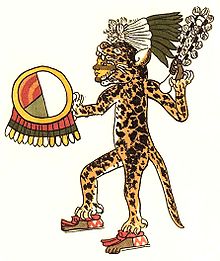Trivia question for Jun-01-2011
Carter is a big cat lover so it is no wonder he chose these guys for his trivia. These guys have often been described as a muscled, heavyweight leopard. These guys once ranged from the southern U.S. to northern Argentina; now extremely rare in most regions; probably extinct in Uruguay, El Salvador, Nicaragua and the southwestern U.S.
Like all cats, these guys are obligate carnivores, feeding only on meat. It is an opportunistic hunter and its diet encompasses 87 species. They prefer large prey and will take adult caiman (a form of small alligator), deer, capybara, tapirs, peccaries, dogs, foxes, and sometimes even anacondas. However, the cat will eat any small species that can be caught, including frogs, mice, birds, fish, sloths, monkeys, and turtles; a study conducted in Cockscomb Basin Wildlife Sanctuary in Belize, for example, revealed that these cats in their area had a diet that consisted primarily of armadillos and pacas. Some of these guys will also take domestic livestock, including adult cattle and horses.
So here are Carter’s questions: Tell us what kind of big-cat this is and tell us what the ancient Aztec warriors used to do with the coat of these animals. Also, when these guys make a kill, tell us what part of their prey they typically eat first.
Good Luck 😉
Answer:
Congratulations to our friends at the Environmental Club (University of Belize) for getting all the questions answered correctly. A special thanks to Gina as well for being the first to answer part of the questions first. Great job everyone. The big cat we featured is in-fact the Jaguar. The Jaguar is a big cat, a feline in the Panthera genus, and is the only Panthera species found in the Americas. The jaguar is the third-largest feline after the tiger and the lion, and the largest in the Western Hemisphere. The jaguar’s present range extends from Southern US and Mexico across much of Central America and south to Paraguay and northern Argentina. Apart from rumors of a possibly breeding population in Arizona (southeast of Tucson), the cat has largely been extirpated from the United States since the early 20th century.
In the Maya civilization, the jaguar was believed to facilitate communication between the living and the dead and to protect the royal household. The Maya saw these powerful felines as their companions in the spiritual world, and a number of Maya rulers bore names that incorporated the Mayan word for jaguar (b’alam in many of the Mayan languages). The Aztec civilization shared this image of the jaguar as the representative of the ruler and as a warrior. The Aztecs formed an elite warrior class known as the Jaguar Knights who proudly wore the coats of these animals to show their strenght.
On killing prey, the jaguar will drag the carcass to a thicket or other secluded spot. It begins eating at the neck and chest, rather than the midsection. The heart and lungs are consumed, followed by the shoulders. Here is more on these mighty carnivores: Jaguar
Thanks for playing along 😉

